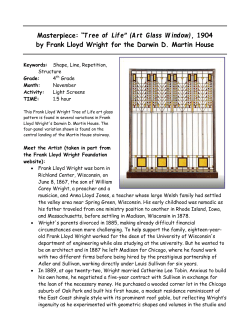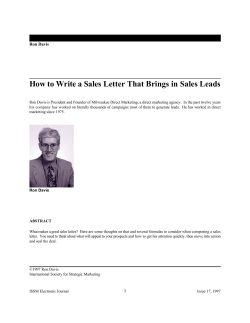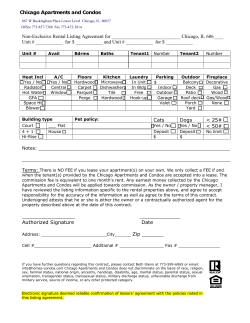
THE WRIGHT FAMILY CATHERINE TOBIN WRIGHT AND THE CHILDREN
THE WRIGHT FAMILY CATHERINE TOBIN WRIGHT AND THE CHILDREN Catherine Lee Tobin was born on March 25, 1871 in Omaha, Nebraska. She grew up in the Kenwood neighborhood of Chicago with her parents, Sam and Flora Tobin, and her three younger brothers. Catherine, a tall and gentle young woman, met Frank Lloyd Wright at a costume party at All Souls’ Unitarian Church in Hyde Park on Chicago’s south side. After a two-year courtship, they married on June 1, 1889. Wright was 21 and “Kitty’ was just 18. With money borrowed from his employer, Louis Sullivan of Adler & Sullivan, Wright purchased a lot at the corner of Chicago and Forest Avenues and began to build a house. The five-room, shingle-style home was completed in the fall of 1889, expanded in 1895, and t he studio was added in 1898. Frank Lloyd Wright, Jr., the first of six children, was born on March 31, 1890. John, Catherine, David, and Frances soon followed. Robert Llewellyn, the last of the Wright children, was born in 1903. During these years, Catherine was busy with the responsibilities of running a household and raising a family. She also established a kindergarten in the playroom addition of their home for the benefit of her own and neighborhood children. Froebel blocks and colored papers were used as teaching tools, and the children played circle games around a red, painted circle on the playroom floor. Wright’s mother, Anna Lloyd Wright, lived next door with her two unmarried daughters. Anna had a very strong personality, and her relationship with her daughter-in-law was strained. Catherine’s parents moved to Oak Park after their daughter’s marriage and lived about a mile away. The children recalled the first ten years of their parents’ marriage as happy. The Wrights entertained often and spent money freely. Life in the house was filled with music, books, and rambunctious children. Catherine had her own artistic interests and encouraged the children with crafts, books, and even Japanese prints. During these years, Catherine was active in the Nineteenth Century Woman’s Club (now known as the Nineteenth Century Charitable Association), as was Anna Wright. Catherine is known as having made the following presentations to the members: Practical Results of the Modern Kindergarten (1896); Art Ideals of Other Lands (1906); Children’s Rights and the Rights of Others (1907). In 1906 she presented a program on A Midsummer Night’s Dream. Catherine was involved in the club’s art, education, and literature departments while she was a member. From 1908-1910, she was the club’s delegate to the Illinois Congress of Mothers. In 1909, Frank Lloyd Wright left his family and went to Europe with Mamah Borthwick Cheney, the wife of a client. Wright returned in 1910 and attempted an unsuccessful reconciliation with Cat herine. In 1911, he converted his Oak Park studio into a home for his family and turned the house into a rental apartment as income for them. He established a new home and studio in Wisconsin, settling there with Mrs. Cheney. After the separation, Catherine became involved with Jane Addams’ Hull House in Chicago and Jessie Binford’s Juvenile Protective Association. She supported the women’s suffrage movement and was active in the Red Cross during World War I. Catherine’s parents died within ten days of ea ch other in 1916. With the money from her inheritance, Catherine and the four youngest children moved to East Division Street in Chicago in 1919. She finally granted Wright a divorce in 1922. In 1930, Catherine married Benjamin Page, a retired Chicago businessman. They lived on his farm in the country, but by 1933 Catherine was back in the Chicago area, continuing her social work. She and Page were divorced in 1937. The years from 1937-1945 were unsettled, with Catherine spending time with her children around the country. In 1945 she moved to California to be near three of her children. Her later years were filled with health problems, and she spent her last decade in sanitariums. Catherine passed away on March 24, 1959 in a Santa Monica sanitarium, just three weeks before the death of Frank Lloyd Wright. Her remains rest in Rosehill Cemetery in Chicago, Illinois. FRANK LLOYD WRIGHT: A BRIEF TIMELINE 1867 Frank Lloyd Wright was born on June 8, 1867 in Richland Center, Wisconsin. Except for a three year period in New England, he spent his boyhood and adolescence in Wisconsin. His mother was a teacher, his father was a preacher. 1876 Wright’s mother, Anna, discovered the Froebel Gifts, educational toys with maple wood blocks and paper for constructions. Wright would later credit these blocks as a fundamental influence on his work, saying that they shaped his perception of rhythmic structure. “...I soon became susceptible to constructive patterns evolving in everything I see.” 1885 Wright began studying engineering at the University of Wisconsin. He left after a few terms without completing his degree. 1887 Wright came to Chicago and joined the office of Joseph Lyman Silsbee, an architect who had erected two buildings for one of Wright’s uncles. He worked briefly for Beers, Clay & Dutton, and then returned to Silsbee’s office. Later in the year, Wright joined the firm of Adler & Sullivan. 1889 Wright married Catherine Tobin and built a home for her on Forest Avenue in Oak Park. The original home was in the Shingle style, one favored by Wright’s first employer, Silsbee. 1890 Frank Lloyd Wright, Jr. was born. Five more children followed in the next thirteen years: John (1892); Catherine (1894); David Samuel (1895); Frances (1898); and Robert Llewellyn (1903). 1893 Chicago hosted the World’s Columbian Exposition. “The Fair reopened wide the case for European Renaissance”, Wright wrote. “The ’Classic’ easily won....The ambitious ignoramus in the architectural profession thought America was captivated...by this overwhelming rise of grandomania (sic). I was confirmed in my fear that a native architecture would be set back for at least fifty years .” However, Wright was introduced to Japanese architecture at the Ho-o-den Pavilion at the fair. Wright left the firm of Adler & Sullivan. Sullivan had loaned Wright the money to build his home in 1889 on the understanding that Wright would do work solely for Sullivan’s firm. Pressed for money for his growing family, Wright did freelance designs of residences in the upstairs front bedroom of his home at night. After Sullivan discovered evidence of this outside work, Wright separated from Sullivan’s firm and set up his own practice in downtown Chicago. 1895 Wright remodeled his home, adding a large dining room and the famous barrel-vaulted playroom. 1896-1897 The House Beautiful book was designed and printed by Wright and William Winslow. 1898 Wright began construction of a studio adjacent to his home. The home had been expanded once already. The studio included an octagonal library with clerestory windows and a two-story drafting room with a balcony suspended by chains from the ceiling. He opens a "front office" and advertises morning hours at Room 1119 of The Rookery in the Loop. During the next ten years, Wright’s practice flourished while he created some of his most important works: the Larkin Building (1903, Buffalo, New York); Unity Temple (1904, Oak Park); and the Robie House (1910, Chicago). Wright and his colleagues started the style that came to be known as Prairie architecture, with homes predominantly horizontal under overhanging roofs, compact but airy in design, and rich in the use of natural building materials. Working with Wright during this period were some of his best-known assistants: Marion Mahony, Walter Burley Griffin, and William Drummond. During these years, Wright used his home and studio as a laboratory to experiment with his new ideas in architecture. 1905 Wright visited Japan for the first time. 1909 Wright left for Europe with Mamah Borthwick Cheney, the wife of a client, effectively ending his period of residence and his practice in Oak Park. 1910 The Wasmuth Portfolio: Ausgefu hrte Bauten und Entwu rfe von Frank Lloyd Wright. Wright’s largest collection of architectural drawings to date was published in Germany. Wright’s international influence and reputation spread rapidly. Wright returned from Europe. He made a brief, unsuccessful attempt at reconciliation with his wife, Catherine. 1911 Wright made a second, three-month visit to Germany. A photographic version of the Wasmuth Portfolio was published. Wright made several alterations to his Oak Park property and then moved with Mrs. Cheney to Spring Green, Wisconsin, where he set up his new home and studio, Taliesin. 1914 Mamah Cheney, her children, and several others were murdered by a domestic worker at Taliesin as they tried to flee a fire he had set. The emperor of Japan sent emissaries to invite Wright to design the new Imperial Hotel. Wright met Miriam Noel, who was to become his second wife. 1915-1922 Wright spent the better part of six years in Tokyo supervising construction of the Imperial Hotel. Frank Lloyd and Catherine Wright were divorced in 1922. 1923 Wright married Miriam Noel. An earthquake and fire destroyed much of Tokyo. Wright’s Imperial Hotel survived to much acclaim. 1923-1929 Wright developed a new style of architecture for clients in southern California. He began experimenting with closed cubicle forms constructed from patterned concrete blocks. 1924 Wright and Miriam Noel separated. 1925 The living quarters of Taliesin burned for a second time. Wright sold his Oak Park Home and Studio. He began living with Olga Lazovich Milanoff. Their daughter, Iovanna, was born on Christmas Day. 1927 Wright and Noel divorced. 1928 Wright and Olga Lazovich Milanoff were married. 1929 Wright began to accept resident apprentices at Taliesin, a practice that continues today. 1935-1956 Two buildings often considered among Wright’s greatest achievements were constructed: Kaufmann Residence Fallingwater (1935, Bear Run, Pennsylvania) and the Johnson Wax Building (1936, Racine, Wisconsin). Wright was also striving to design modest, middle-class homes with aesthetic value. These “Usonian” homes had heated concrete floor slabs, brick cores, and boards and roofing paper skillfully sandwiched for walls. 1943-1956 Wright designed the spiral ramp for the Guggenheim Museum in New York, but construction was not begun until 1956. The building was completed in 1959. 1945-1959 From the end of World War II until his death, Frank Lloyd Wright received many honors and awards. In his last few years, Wright designed Chicago’s never- built “Mile High Skyscraper” (500 stories tall) and saw construction begin on Annunciation Greek Orthodox Church (1956, Milwaukee); the Marin County Civic Center (1957, Marin County, California); and many of the buildings on the Florida Southern University campus. According to archives at Taliesin West, when Wright died on April 9, 1959 (at the age of 91), he had designed more than 1,191 buildings, 460 of these were actually constructed. Of those built, 76 have been demolished. Wright saw his task as one of great social importance, s eeing the “architect as the savior of the culture of modern American society.” Wright’s energy, imagination, vision, and creativity are reflected in the staggering output of his career. [Return to Syllabus]
© Copyright 2025


















